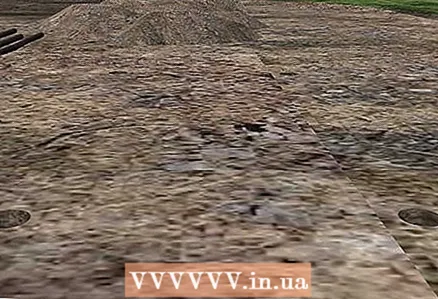
Content
If you find yourself in the jungle, far from civilization and homeless, creating a shelter from available materials will help you hide from the rain while you sleep, and will provide you with a dry and safe place. This article describes two types of shelters, one is very simple, but on the ground, the other requires a lot of effort, but it is suspended.
Steps
 1 When choosing a place for a bivouac in the jungle, always keep the following things in mind:
1 When choosing a place for a bivouac in the jungle, always keep the following things in mind:- Avoid ant paths and animal paths.

- Avoid settling soil.

- Avoid places that will quickly fill with water in the event of a flash flood.

- Choose hills that are away from swamps and dry riverbeds.

- Avoid ant paths and animal paths.
 2 Cut and tie whatever you can. Since you will have to procure raw materials, cut and tie everything together, you must use your ingenuity and find materials that can replace what you need, unless you carry a knife and rope in your pocket. Some options include:
2 Cut and tie whatever you can. Since you will have to procure raw materials, cut and tie everything together, you must use your ingenuity and find materials that can replace what you need, unless you carry a knife and rope in your pocket. Some options include: - Sharpened stick, sharpened cutting stones

- Vines, reeds, handkerchiefs, pieces of clothing, strong young tree shoots, etc. for tying

- Leaves, grass, lumps of moss, etc. for bed, blankets and warmth.

- Sharpened stick, sharpened cutting stones
Method 1 of 2: Shelter Type 1
This is a very simple shelter that can be easily built by one person or people with low energy levels. While this is an advantage, in a jungle environment, this type of shelter leaves you open to terrestrial hazards such as water, animals, fungi and cold, so choose a location with great care and only use this type of shelter when you most likely will not encounter dampness, cold and animals.
 1 Choose a suitable location. When building a temporary shelter, follow the same guidelines as when choosing a suitable resting place. Look for a place between two small trees, the distance between which is 1.5 meters per person; if there are more people, make it wider.
1 Choose a suitable location. When building a temporary shelter, follow the same guidelines as when choosing a suitable resting place. Look for a place between two small trees, the distance between which is 1.5 meters per person; if there are more people, make it wider.  2 Build the support frame from the branches as shown in the picture. The length of the cover should cover you from head to toe; suitable length about 2 meters. Tie the branches tightly together to support the weight of the shelter.
2 Build the support frame from the branches as shown in the picture. The length of the cover should cover you from head to toe; suitable length about 2 meters. Tie the branches tightly together to support the weight of the shelter.  3 Add some branches that you will anchor to the horizontal of the main frame. Natural branching on branches and hemp should be used to support the horizontal branch, as shown in the picture.
3 Add some branches that you will anchor to the horizontal of the main frame. Natural branching on branches and hemp should be used to support the horizontal branch, as shown in the picture.  4 Repeat the same, but reinforce the vertical branches. Check that the branches are well connected and that they are firmly driven into the ground so that the poles do not move. Your frame is ready.
4 Repeat the same, but reinforce the vertical branches. Check that the branches are well connected and that they are firmly driven into the ground so that the poles do not move. Your frame is ready.  5 Cover the entire structure with green leaves. They should be used without tearing them off the thin twigs and stems. It is best to choose plants with wide leaves as they add protection to your hiding place.
5 Cover the entire structure with green leaves. They should be used without tearing them off the thin twigs and stems. It is best to choose plants with wide leaves as they add protection to your hiding place. - Stack branches with leaves on top of others until they block out the sun. You will need about three to four layers.
- Start layering the leaves from the bottom end. This will create an even slope and allow the water to flow down rather than stagnate.
- You may need to tie the leaves to hold them in place.
Method 2 of 2: Shelter Type 2
This type of shelter is represented by a jungle survival shed. It better protects against hazards such as water or even flash floods, insects, curious wildlife, fungal and parasitic infections, and cold. It is imperative to avoid areas with high groundwater levels and low pressure resistance, moist soil, undergrowth and tree roots, as the hut will lift you off the ground and distribute your weight over a larger area. On the other hand, it takes a lot of effort to build. Instead, you can build a swamp bed.
 1 Choose a suitable place and clean it from vegetation. This area should match the width and height of your body (as well as any other people in need of cover).
1 Choose a suitable place and clean it from vegetation. This area should match the width and height of your body (as well as any other people in need of cover).  2 Find four logs of approximately the same size, bamboo poles or twigs, shoulder-length and about 15 cm wide. Remove twigs, twigs and leaves from these "poles".
2 Find four logs of approximately the same size, bamboo poles or twigs, shoulder-length and about 15 cm wide. Remove twigs, twigs and leaves from these "poles". - Using a sharpened stick, dig out four pole holes. The pits should represent the size of your shelter.

- Drive the poles into the ground until they settle to the level of your waist; approximately the poles need to be pushed into the ground 30 cm.

- Using a sharpened stick, dig out four pole holes. The pits should represent the size of your shelter.
 3 In the middle of each pole, at knee level, cut out the notches for the poles. For this purpose, use a pocket knife or a sharpened stick. Rotate each notch and expand to 2.5cm.
3 In the middle of each pole, at knee level, cut out the notches for the poles. For this purpose, use a pocket knife or a sharpened stick. Rotate each notch and expand to 2.5cm.  4 Prepare the material for the frame. To do this, collect six straight stems or branches about 10 cm in diameter. They should be straight and sturdy to support your weight.
4 Prepare the material for the frame. To do this, collect six straight stems or branches about 10 cm in diameter. They should be straight and sturdy to support your weight. - Length: 2 poles should be 60 cm longer than the width of the shelter, and the remaining 4 poles should be 60 cm longer than the shelter.
 5 Make the frame of the hut. Use one of the two short poles and place them in the slots at the head of the cover. Do the same at the foot of the shelter. This will form the frame cross members. Secure everything with rope, reed, vine, grass, scarf, etc. Along the edges of the beams, leave an overlap about 30 cm long so that you can put a side frame on it.
5 Make the frame of the hut. Use one of the two short poles and place them in the slots at the head of the cover. Do the same at the foot of the shelter. This will form the frame cross members. Secure everything with rope, reed, vine, grass, scarf, etc. Along the edges of the beams, leave an overlap about 30 cm long so that you can put a side frame on it.  6 Make a side frame. Use long poles, place them on the sides of the shelter, placing them on the already prepared crossbars.
6 Make a side frame. Use long poles, place them on the sides of the shelter, placing them on the already prepared crossbars.  7 Make a flooring or bed for sleeping in the hut. Collect a dozen straight branches 5 cm in diameter and 60 cm longer than the width of the shelter. Place them along the side frame cross members to form the bed base and tie them together.
7 Make a flooring or bed for sleeping in the hut. Collect a dozen straight branches 5 cm in diameter and 60 cm longer than the width of the shelter. Place them along the side frame cross members to form the bed base and tie them together.  8 Find the material for the roof. Look for five straight branches or saplings 5 cm in diameter.
8 Find the material for the roof. Look for five straight branches or saplings 5 cm in diameter. - One of the branches should be 60 cm longer than the length of the hut (it will become the ridge of the roof).

- The remaining four branches should exceed the width of the shelter by 60 cm (they will form the basis of the pediment).
- One of the branches should be 60 cm longer than the length of the hut (it will become the ridge of the roof).
 9 Fold down the roof. As with the base, cut the outer grooves 2.5 to 5 cm from the top of the poles. Insert the unused, good poles into them to become the rungs for the base. Tie tight.
9 Fold down the roof. As with the base, cut the outer grooves 2.5 to 5 cm from the top of the poles. Insert the unused, good poles into them to become the rungs for the base. Tie tight. - Take the branches for the pediment.Tie them together at the desired angle, then tie the ends of the structure at the head of the shelter.

- Repeat the steps with the bottom of the hut. Note, if you don't want to build a pediment, just lay branches and leaves across the rails to create a flat roof. The only problem is that if a lot of water gets on such a roof, it has nowhere to drain and the moisture will simply fall on you, soaking through.

- Tie a V-shaped skate pole at the top of each pediment so your roof will have a longitudinal bar.

- Take the branches for the pediment.Tie them together at the desired angle, then tie the ends of the structure at the head of the shelter.
 10 Cover the roof. Use twigs about 1 inch (2.5 cm) thick to connect the ends of the shelter horizontally. Tie them tightly into place.
10 Cover the roof. Use twigs about 1 inch (2.5 cm) thick to connect the ends of the shelter horizontally. Tie them tightly into place. - Line wide leaves on top of the branches in a shingle style.
- Line wide leaves on top of the branches in a shingle style.
Tips
- You can also build the walls of the hut and cover them with leaves, improving protection from rain.
- Build yourself a bed so you don't have to lie on the jungle forest floor. This is important for keeping warm and safe. Again, you can use twigs with leaves or even grass.
- Test the hut to see if it can withstand the rain. Pour water (slowly and proportionally) over the hut and see if water seeps in or runs down the roof. If it seeps, add more layers.
Warnings
- Unless you find yourself in the jungle after an accident, never go unprepared. At the very least, bring a machete, poncho, hammock, mosquito net, sufficient fuel and food. Before you start exploring the jungle, read books and talk to locals.
- These huts are extremely temporary. They may need to be rebuilt every night, which requires shelter during bad weather, and especially if you move from place to place. Keep this in mind when making the more complex version.
- Look for insects in the leaves and branches you use for your hiding place. Ants, spiders, snakes, or any other small creatures that live in branches and leaves can become a huge problem.
What do you need
- Tackle - this can be a rope or lace that you have with you. In addition, there are many vines and aerial roots in the jungle (vines on the left in the picture, aerial roots on the right). If you use them, make sure they are still green as dry vines and roots break easily.
- Branches - Branches will help you create the structure and frame of your hut. For different parts of the shelter, you will need different sized branches.
- Leaves - will become a protective element of your hut, and keep the rain. Green vegetation works best. Choose plants with wide leaves; for example, an excellent selection of palm subspecies.
- A knife or other cutting tool is extremely important when it comes to trimming the size of materials.



